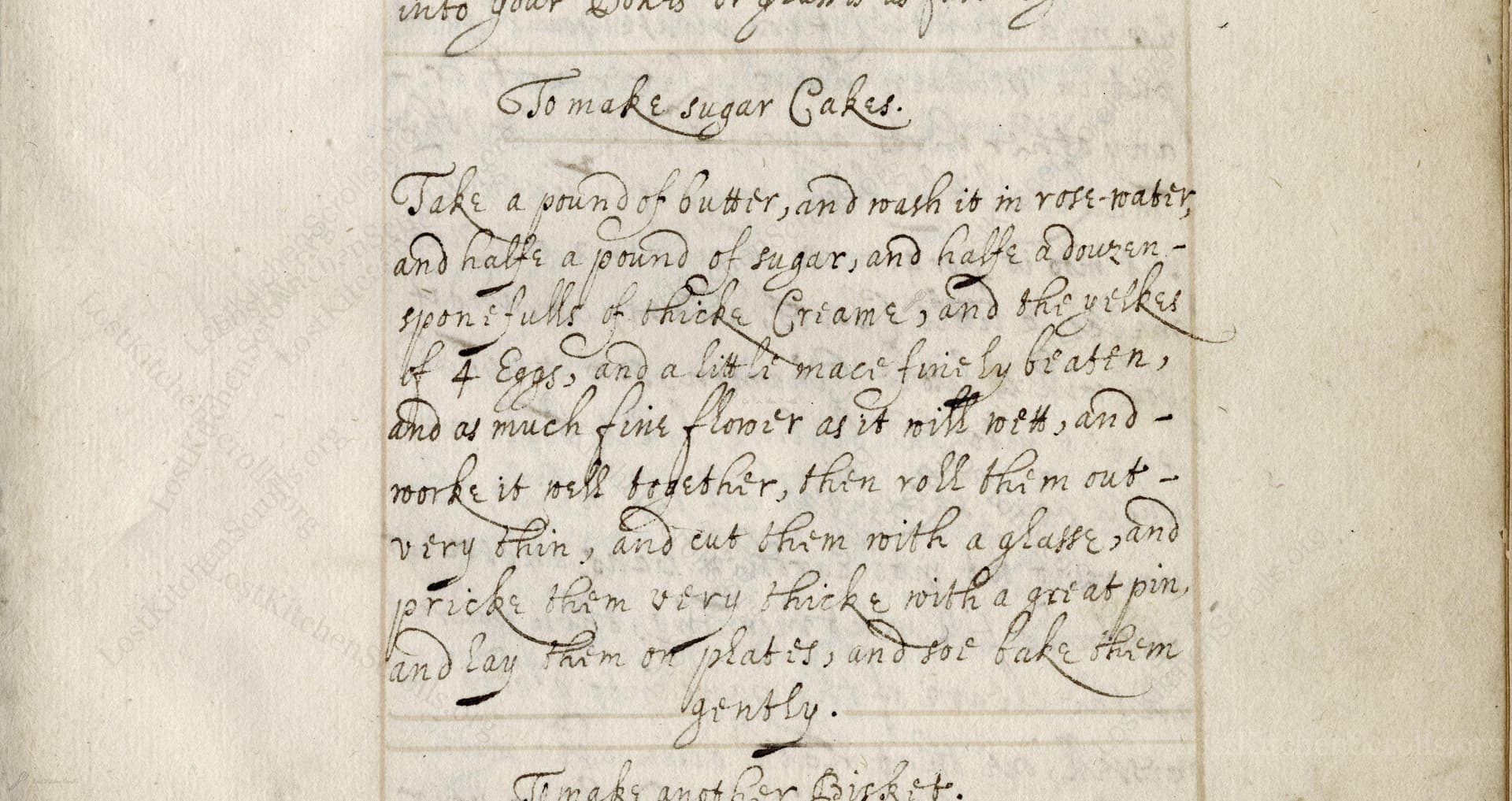To Make Sugar Cakes
From the treasured pages of Receipt book of Sarah Longe
Written by Sarah Longe

To Make Sugar Cakes
"Take a pound of butterr, and wash it in rose-water, and halfe a pound of sugar, and halfe a douzan - spone fulls of thicke Creame, and the yelkes of 4 Eggs, and a litti maci finely beaten, and as much fine Flower as it will take, and - woorke it well together, then roll them out - very thin, and cut them with a glasse, and pricke them very thicke, with a great pin. and lay them on plates, and soe bake them gently."
Note on the Original Text
This recipe is written in the charming, direct vernacular of early modern English. Measurements are mostly descriptive—'a pound,' 'half a dozen spoonfuls,' etc.—which relied upon the intuitive skill and muscle memory of the cook. Spelling (e.g., 'spone' for 'spoon', 'Flower' for 'flour', or 'litti maci' for 'a little mace') followed no standard, since spelling conventions were not fully fixed at the time. The instructions focus on technique and sequence rather than strict timing or temperature, leaving much to the discretion of the experienced household cook.

Title
Receipt book of Sarah Longe (1610)
You can also click the book image above to peruse the original tome
Writer
Sarah Longe
Era
1610
Publisher
Unknown
Background
A delightful glimpse into early 17th-century kitchens, this collection by Sarah Longe whisks readers through ancestral recipes, cooking tips, and the seasonings that graced the tables of Jacobean England. Prepare to savor the tastes and traditions of times gone by.
Kindly made available by
Folger Shakespeare Library
This recipe hails from early 17th-century England, a time when sugar was a luxury ingredient and subtle aromatics like rosewater and mace connoted status and refinement. Created by Sarah Longe around 1610, these 'sugar cakes' would be served in elite households for special occasions or as part of a banqueting course, when guests indulged in a variety of sweetmeats and biscuits. The baking method itself hints at the transition from medieval spice-laden confections to the simpler, buttery cakes and biscuits that would later flourish in British baking. The use of rosewater and eggs betrays influences both continental and Elizabethan in style.

In the early 1600s, the ingredients would have been mixed in a large earthenware bowl or wooden trough, using a wooden spoon or even hands for creaming. Rolling pins (often simple dowels) smoothed out the dough, and a common drinking glass served as an impromptu cutter. Pricking would be done with a large metal pin or skewer to keep the cakes flat during baking. Baking took place on metal plates – likely pewter or tin, set in an open-hearth oven, and watched carefully to ensure a gentle, even bake.
Prep Time
20 mins
Cook Time
12 mins
Servings
18
We've done our best to adapt this historical recipe for modern kitchens, but some details may still need refinement. We warmly welcome feedback from fellow cooks and culinary historians — your insights support the entire community!
Ingredients
- 8 oz unsalted butter
- 2 tbsp rosewater (for washing butter)
- 1/2 cup white granulated sugar
- 6 tbsp (1/4 cup + 2 tbsp or 3 fl oz) double cream (thick cream)
- 4 egg yolks (medium eggs)
- 1/8 tsp ground mace (or nutmeg as substitute)
- 2 3/4 cups plain wheat flour (approximate, as needed)
Instructions
- To recreate these early 17th-century sugar cakes, begin by bringing 8 oz of unsalted butter to room temperature.
- Wash it briefly in a little rosewater (about 2 tablespoons), patting off excess liquid – this imparts a delicate floral note as per the original.
- Add 1/2 cup white sugar, 6 tablespoons of thick double cream, and the yolks of 4 medium eggs.
- Finely grate a small pinch (about 1/8 teaspoon) of nutmeg in place of mace, if mace is unavailable.
- Mix these thoroughly until homogeneous.
- Gradually incorporate enough plain white flour (about 2 3/4 cups, but use as needed for a soft, not sticky dough).
- Work it into a smooth paste.
- Roll out the dough very thin – about 1/8 inch thick.
- Use a glass as a cutter to form rounds.
- Prick the surface of each cake thoroughly with a fork or skewer.
- Place onto parchment-lined baking sheets and bake at 320°F for 10-15 minutes, until lightly golden.
- These sugar cakes are crisp, delicately flavored, and a wonderful nod to early modern British baking.
Estimated Calories
110 per serving
Cooking Estimates
It takes about 20 minutes to make the dough and cut out the cakes, and about 12 minutes to bake them. Each cake has around 110 calories if you make 18 cakes.
As noted above, we have made our best effort to translate and adapt this historical recipe for modern kitchens, taking into account ingredients nowadays, cooking techniques, measurements, and so on. However, historical recipes often contain assumptions that require interpretation.
We'd love for anyone to help improve these adaptations. Community contributions are highly welcome. If you have suggestions, corrections, or cooking tips based on your experience with this recipe, please share them below.
Join the Discussion
Rate This Recipe

Den Bockfisch In Einer Fleisch Suppen Zu Kochen
This recipe hails from a German manuscript cookbook compiled in 1696, a time whe...

Die Grieß Nudlen Zumachen
This recipe comes from a rather mysterious manuscript cookbook, penned anonymous...

Ein Boudain
This recipe comes from an anonymous German-language manuscript cookbook from 169...

Ein Gesaltzen Citroni
This recipe, dating from 1696, comes from an extensive anonymous German cookbook...
Browse our complete collection of time-honored recipes



